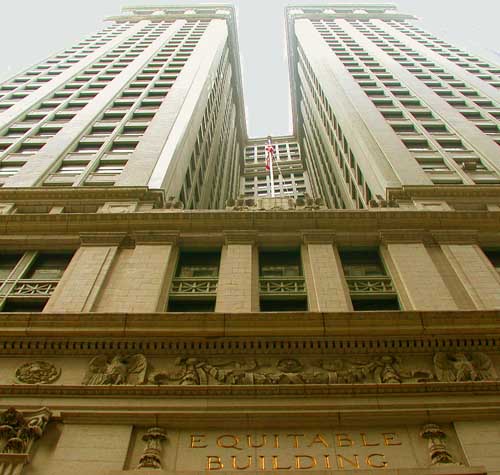- Equitable Building (Manhattan)
Infobox nrhp
name = Equitable Building
nrhp_type = nhl

caption = Equitable Building, viewed from street level
location =Lower Manhattan ,New York City , NY
nearest_city =
lat_degrees = 40
lat_minutes = 42
lat_seconds = 35
lat_direction = N
long_degrees = 74
long_minutes = 00
long_seconds = 40
long_direction = W
area =
built = 1915
architect =Ernest R. Graham
architecture = Neoclassical
designated =June 02 ,1978 cite web|url=http://tps.cr.nps.gov/nhl/detail.cfm?ResourceId=1771&ResourceType=Building
title=Equitable Building|date=2007-09-12|work=National Historic Landmark summary listing|publisher=National Park Service]
added =June 02 ,1978 cite web|url=http://www.nr.nps.gov/|title=National Register Information System|date=2007-01-23|work=National Register of Historic Places|publisher=National Park Service]
visitation_num =
visitation_year =
refnum = 78001869
mpsub =
governing_body =Silverstein Properties, Inc. The Equitable Building is a 36-story office building inNew York City , located at 120 Broadway in the Financial District ofLower Manhattan . A landmark engineering achievement as askyscraper , it was designed byErnest R. Graham and completed in 1915. The controversy surrounding its construction contributed to the adoption of the first modern building andzoning restrictions on vertical structures in Manhattan. Although it is now dwarfed by taller buildings in its vicinity, it still retains a distinctive identity in its surroundings on Lower Broadway. It was designated aNational Historic Landmark in 1978.cite web|url=http://tps.cr.nps.gov/nhl/detail.cfm?ResourceId=1771&ResourceType=Building
title=Equitable Building|date=2007-09-12|work=National Historic Landmark summary listing|publisher=National Park Service] cite web|url=PDFlink| [http://pdfhost.focus.nps.gov/docs/NHLS/Text/78001869.pdf "Equitable Building", by George R. Adams] |1.16 MiB |title=National Register of Historic Places Inventory-Nomination|date=1977-01|publisher=National Park Service] cite web|url=PDFlink| [http://pdfhost.focus.nps.gov/docs/NHLS/Photos/78001869.pdf Equitable Building--Accompanying Photos, exterior and interior, from 1976, plus c.1915 drawing.] |888 KiB |title=National Register of Historic Places Inventory-Nomination|date=1977-01|publisher=National Park Service]Description
The building is in the neoclassical style, rising 538 ft (164 m) with a total floor area of 1,849,394 square feet (176,000 m²), giving a
floor area ratio of 30. Upon its completion, the building was the largest (in total floor area) in the world. It rises as a single tower with the appearance of two separate identical towers standing side by side, connected by a wing for the whole height of the building, such that it appears in the shape of the letter "H" when viewed from above. A striking feature of the building by modern standards is that it has no setback from the street beyond the depth of the sidewalk, rising vertically for all its floors.The building has a through-block entrance lobby with a pink
marble floor, sand-colored marble walls and a vaulted,coffered ceiling . It has approximately 5,000 windows. It once housed the exclusive Bankers Club on its top three floors. The white marble of the building isYule marble , quarried inMarble, Colorado and which is also the source used for theTomb of the Unknowns and theLincoln Memorial .The building occupies the entire block, and is bordered by Broadway to the West, Cedar Street to the North, Nassau Street to the East, and Pine Street to the South.
History
The building was constructed as the headquarters of
The Equitable Life Assurance Society of the United States . The site had previously been intended in 1906 for a 62-story tower designed byDaniel H. Burnham , but the project had been postponed. When the Equitable's previous headquarters were destroyed by fire in 1912, the site was chosen as the location of its new headquarters. It was originally intended to be 40 stories high, but it was reduced by four floors on the advice of consulting engineer Charles Knox, who determined the lower height as being optimal for itselevator s.Opponents of the buildings were outraged at the unprecedented volume of the building, which cast a 7 acre (28,000 m²) shadow on the surrounding streets. Many New Yorkers feared that further construction of buildings like it would turn Manhattan into an unpleasant and dark maze of streets. In response, the city adopted the
1916 Zoning Resolution which limited the height and required setbacks for new buildings to allow the penetration of sunlight to street level. Specifically, new buildings were afterwards required to withdraw progressively at a defined angle from the street as they rose, in order to preserve sunlight and the open atmosphere in their surroundings. As a consequence of the new restrictions, the building remained the largest office building by volume in the world until the construction of theEmpire State Building in 1931.The setback code led to adoption of styles such as that of the
Chrysler Building and Empire State Building with tiered architecture in its top floors. By the 1960s, many architects had responded to the code by adopting theplaza style of architecture, in which vertical buildings rose from the middle of a concrete plaza, such as the Twin Towers of theWorld Trade Center .Present day
The Equitable Building, which is owned by
Silverstein Properties, Inc. , houses the offices of theNew York State Attorney General ,Spear, Leeds & Kellogg , and others. After buying the building in 1980,Larry Silverstein had the building renovated and restored at a cost of $30 million, [cite news |title=Abrams's New Office Downtown |publisher=New York Times |date=1986-05-07 |author=Kennedy, Shawn G.] with renovations completed in 1990. [cite book |title=AIA Guide to New York City, Fourth edition |author=White, Norval, Elliot Willensky |publisher=Three Rivers Press |year=2000]The stretch of lower Broadway where the building sits has since become the traditional route of
ticker-tape parade s in Manhattan. The route past the building is known colloquially as theCanyon of Heroes , in part because of the sheer verticality of the building and others around it.References
External links
* [http://www.greatgridlock.net/NYC/nyc1a.html The Equitable Building]
* [http://www.emporis.com/en/wm/bu/?id=115589 Emporis profile]
Wikimedia Foundation. 2010.
